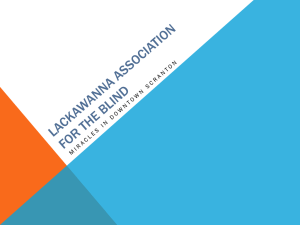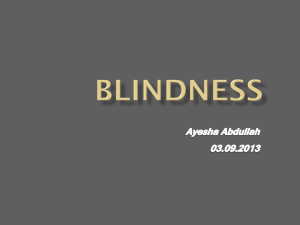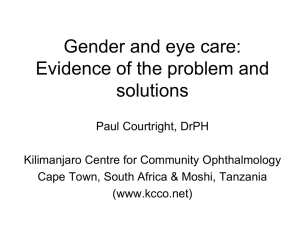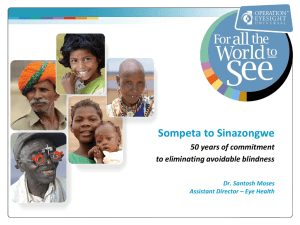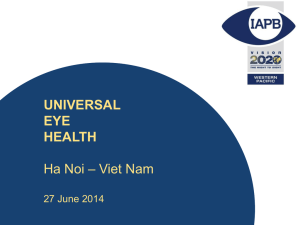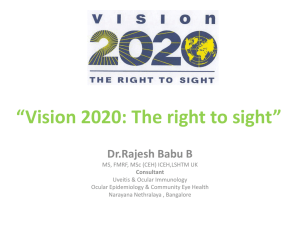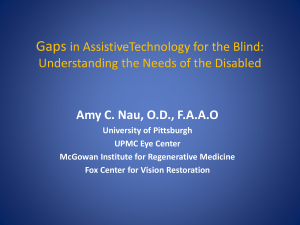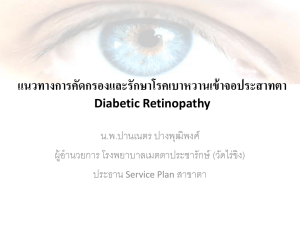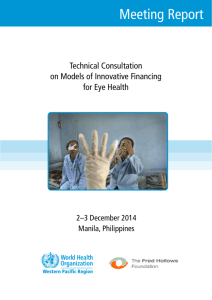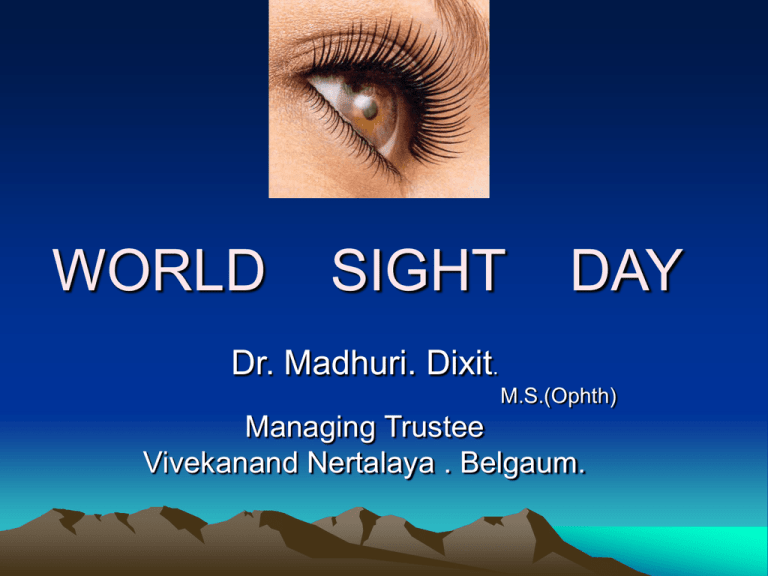
WORLD
SIGHT
DAY
Dr. Madhuri. Dixit.
M.S.(Ophth)
Managing Trustee
Vivekanand Nertalaya . Belgaum.
WSD
• World Sight Day (WSD) is an
annual day of awareness held
on the second Thursday of
October, to focus global
attention on blindness and
vision impairment.
The global day for awareness of
blindness and vision impairment
WHY
WSD
• Raise public awareness of blindness & vision
impairment as major international public
health issues
• Influence Governments/Ministers of Health to
participate in and designate funds for
national blindness prevention programmes
• Educate target audiences about blindness
prevention, about VISION 2020 and its
activities, and to generate support for VISION
2020 programme activities
What is VISION 2020
VISION 2020 : the Right to Sight
VISION 2020
Working together to
eliminate
avoidable blindness
VISION 2020 Partnerships
WHO
Technical
Assistance
Capacity
Building
National Partners - National Vision 2020 Plans
Sustainable program delivery
What is Avoidable Blindness
• Avoidable blindness is defined as
blindness which could be
either treated or prevented by
known, cost-effective means.
Global Avoidable Blindness
37 million
INDIAN SENARIO
India has HIGHEST number of
blind globaly-12 MILLION
Every year 2 MILLIONS are
added
62% are from CATARACT
NPCB from 1976 supported by
World bank
India: a land of contrasts
•
Very Rich
•
Levels of rising
“overnutrition”
•
•
•
World class
academies and
institutes.
World class
health care
facilities and
booming health
tourism
Women with
education, power
and influence
•
A third of the world’s
poor, nearly
400million living on
less than $1/day
•
46% of children
malnourished
•
Highest number of
illiterate people in
the world
•
The infant mortality
rate of 57/1000 live
births.
•
Sex ratio of 933
females/1000 males
Source: 1) Sample Registration System 2003- Annual Report, Office of the Registrar General, India
2) census of India 2001
3) Department of International Development (DFID)
Gender Disparity
• Gender disparity are high in almost in every sector of health
sector
Prevalence of cataract more in females than males
• In addition, there exists spatial disparities between urban and
rural areas, and across Sates
• RAAB 2007: prevalence of
blindness 9.2% in women and
6.6% in men (over 50)
5% lower rate of IOL
implantation
• State to State Cataract
Surgical Rate (CSR) varies from
500 to 6,000
INNOVATIVE INITIATIONS
• Vivekanand Netralaya.Belgaum.
(Priyadarshini Eye Health Care
&Reseach Foundation)
• Clear Mission for VISION”Comprehensive qwality eye care for
poor & underpriviledged blind people
, free of cost & training medical &
paramedical peressonel for this noble
cause .”
INNOVATIVE INITIATIONS
Vivekanand Netralaya
How we work?
•
•
•
•
•
•
•
Focus is only on underpriveledged
Reaching out to them in remote places
Identifying cataract patients
Trasporting them to base hospital
Catract removal with IOL Implantation
Transporting back to their villages
Follow up
Vivekanand Netralaya
Belgaum
• Total No. of Cataract operations
5070
• 99.99% with IOL
• More females than males
Blindness Scenario in India
13%
Causes of Blindness in India
11.4%
35%
0.9%
5.8%
19.7%
62.2%
41%
11%
Pvt. Hosp.
NGO Hosp
Govt. Hosp.
Eye Camp
Cataract
Uncorrected Refractive Errors
Glaucoma
Diseases of Cornea
Others including Leprosy, diabetic retinopathy etc
Emerging priorities and patterns of
eye diseases
• Cataract remains the leading cause of
blindness despite impressive advancements in
surgical services.
• Uncorrected Refractive Errors is now
recognised as the second leading cause,
followed by Glaucoma, cornea.
• Childhood Blindness is now gaining
attention.
• Diabetic Retinopathy is now becoming a
major problem.
• Despite an over increasing need, low vision
services are dramatically lacking
Cataract
CSR
First cause of blindness
(~50%)
– backlog: 20 million
un-operated cases
– only 10 million
surgeries year
• major constraints :
– coverage
– access
– quality
6000
5000
4000
3000
2000
1000
0
USA
EU
India Lat.Am Africa China
Cataract operations/million population/year
Cataract Surgical Rate in India
2001 - 2002
2003 - 2004
WHO 2004
SICS Ray of hope to combat
avoidable blindness due to
Cataract
• Easy
• Effective
• Economical
Childhood Blindness in India
• 320,000 children are blind (19% of the world’s blind children)
• 50% of these cases are treatable or preventable
• In addition, an estimated 9.2 million children are visually
impaired
• Causes: Cataract, Ref Errors, Corneal ulcer/ opacity, ROP,
Glaucoma
• Life expectancy of a blind child is assumed to be 48 years,
resulting in a loss of 33 working years
• Burden of childhood blindness measured in blind-person
years is next only to cataract.
• Loss estimated to India’s GNP is US$11.1 billion
Analysis of blindness profile in Blind School
Blindness profile in Blind School
Congenital Cause
25 %
Treatable and Curable
62.5 %
Acquired Cause
75 %
Not Treatable
37.5 %
37.5 % of 25 % i.e.
9 out of 100 cases untreatable
Treatable
Corneal Blindness Scenario - India
Backlog of corneal blind people
:
1.1 million
Added every year
:
25,000 - 30,000
Corneas required / year
:
Corneas collected / year
75,000 - 1,00,000
: 28,000 - 30,000
Cornea utilized for sight restoration: 12,000 - 15,000
Collection vs. Utilization
:
40-55%
Need for Eye Banking
Non availability of grafts
Lack of quality in preservation & assessment
of cornea tissue
Lack of trained human resources
Lack of standardized protocols, accreditation
& need for appropriate legislation
Lack of awareness of eye donation (gap
between pledge and actual donation)
Diabetes rising worldwide
Nearly 171 Million Worldwide have Diabetes
•
Likely to double to nearly 366 million by 2030.
Population [Million]
•
India
China
US
Russia Germany
DR Scenario - India
Diabetic Population [Million]
90
70
•
5.5 % Diabetic prevalence
Rate
•
1/3 to 1/5 of Diabetic patients
have DR
•
There may be approximately
11-20 million with diabetic
retinopathy by 2025
•
75% diabetic for more than 20
years will develop some form
of diabetic retinopathy
•
If not contained, India may be
home for the largest number
of diabetic blind
57
60
50
30
An estimated 200% increase in
next two decades
79.4
80
40
•
40.9
29
31.7
20
10
0
1995
2002
2007
#2025
#2030
(Source: WHO)
Reasons for Rise in Diabetes
Denial of diabetes and no regular treatment
Limited awareness of diabetes and related eye disease
Asymptomatic nature of DR gives patient no warning
No routine eye examination as a health seeking behavior
Misconceptions:
Controlling blood sugar levels eliminates the risk of visual loss
If I can see well, why seek medical help
Gaps in Eye Care Program
Poverty
Human Resources:
Eye Care Delivery System
Quality
Equity
Under utilized HR:
12,000 ophthalmologist
Of them 50% surgically inactive
(Need of 25,000 by 2020)
The ophthalmology population ratio
Urban1:25,000
National & sub national structures Rural 1:250,000
Supply and Equipment
Urban - rural divide
Lack of mid level personnel
Current :24,000; need 75,000
Life style
Long life expectancy
Remoteness and lack of
awareness & health promotion
Eye Health Promotion is the “key”
to early detection.
&
Early Detection is the “key” to
early intervention.
&
Early Intervention is the “key” to
controlling avoidable blindness.
LET US
ACT NOW
• One person goes blind every 5
seconds and One child goes
blind every minute
• Without proper interventions 76
million people could be blind by
year 2020
Through collaboration let
us commit to bring light &
smile to as many as blind
fellow human beings
Together we can
make a difference.
Thank you for your
kind attention

